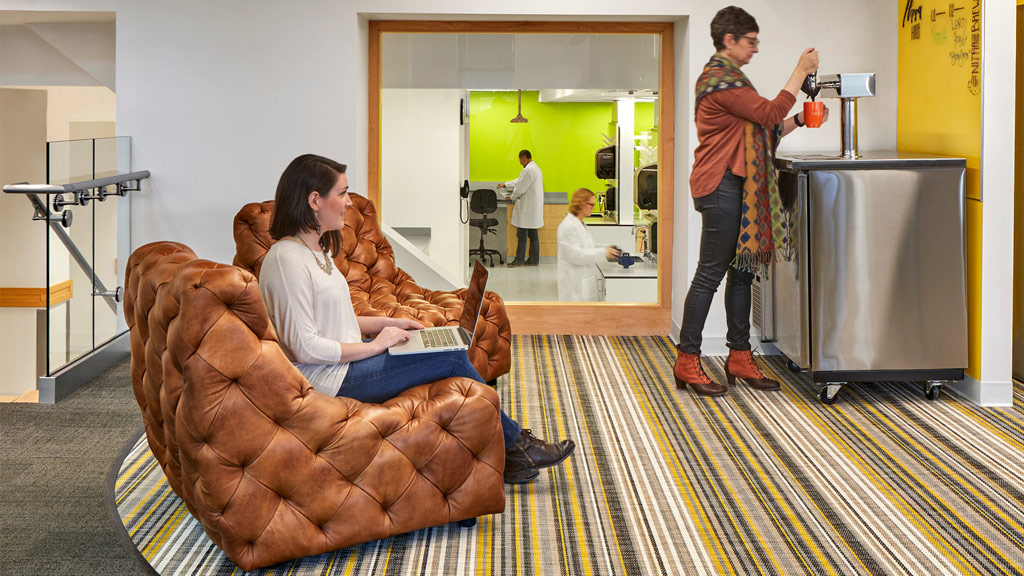Coworking Accelerates Life Science Startup Timelines
November 09, 2020 | By Erik Lustgarten
In 2007, just two years after the term “WiFi” was added to Miriam Webster’s dictionary, there were about 14 coworking spaces across the country. By September of 2018 there were 19,000 around the world. Empowered by technology, shared resources, and the support of a community of freelancers and small businesses, coworking quickly became a new model for working and established its image as a magnet for independent, diverse, and creative entrepreneurs.
Around the same time, the high costs of R&D and impending patent expiries were pushing the Bio-Pharma industry to become more agile. The need to grow their drug development pipelines and accelerate therapies to the market resulted in increased mergers, acquisitions, and strategic partnerships, but also a new emphasis on spanning the funding “valley of death” between academia and industry. New models emerged, including co-working for scientists, to connect early stage companies to the capital and resources required to pursue and commercialize promising science.
Starting a company and raising capital to develop a therapy is hard enough work to begin with. Scientific entrepreneurs are then faced with high rents, lab construction costs that are 2-3 times what an office would be, the cost of furnishing cutting edge scientific equipment, and the daunting operational and safety concerns of starting a research lab. According to Johannes Fruehauf, M.D., PhD., President and CEO of Biolabs, “The coworking model can reduce science startup costs by a factor of 10 and accelerate the timeline for setting up a lab facility by 6 to 9 months.” The coworking model for scientists offers leasing advantages, immediately usable space, and a ready-made entrepreneurial community. Looking at the work that Gensler has done around the globe, there are three consistent principles that unite the approaches of leading companies developing laboratory coworking:
Principle One: Let the scientist just do scienceAs with any good research facility design, it’s important to start with the operational model. According to Alan Koder, who is a Director of Life Sciences with CBRE, “The ability to move into a lab and start research within weeks of securing financing carries tremendous value to start-ups. This is true not only for companies in that very early phase, but also when they need to grow beyond an incubator’s capacity. Turnkey, flexible space with shared elements can be of great value post-graduation.” Removing the challenges of building out labs, procuring scientific equipment, securing environmental permits, and developing vendor relationships allows entrepreneurs to put investment capital directly into the idea.
Principle Two: Connect entrepreneurs with the resources they need to growTo succeed, entrepreneurs need not only the physical resources of benches, equipment, and a safe facility to work in, but also conduits to investment capital, legal advisors, industry and academic partners, and most importantly the mentorship of more experienced entrepreneurs. It’s no coincidence that most coworking labs are located in strong academic and science clusters where an established support network of suppliers, advisors, and investors can be engaged to generate a robust network of supporters with a shared interest in advancing science.
Principle Three: Cultivate a distinct, supportive cultureOne only needs to spend a few minutes looking at the LabCentral events page to recognize a playful but deliberately cultivated community. Scientific partnerships are often based on not only value, but also on trust forged through social interaction. Hospitality inspired spaces for meetings and events reinforce a shared commitment to accelerating scientific discovery, enable rewarding social experiences, and nurture a culture of collaboration and entrepreneurship.
There are several projects that that we are working on that are offering a glimpse into coworking for science 2.0. Connecting people will continue to be vital, but coworking laboratories in the near future will need to be nimble and adaptable to meet the needs of companies that will not fit into a single scientific typecast. They will also engage more companies on a grander scale. We at the early stages of connecting the dots between the advances in different fields that have occurred over the last decade, and the shared resources, structure for growth, and connected community of the coworking lab model make it an ideal catalyst for future innovation.
For media inquiries, email .

